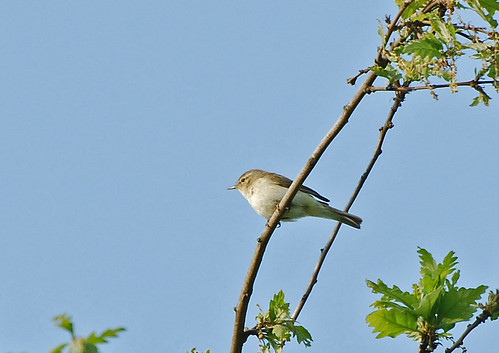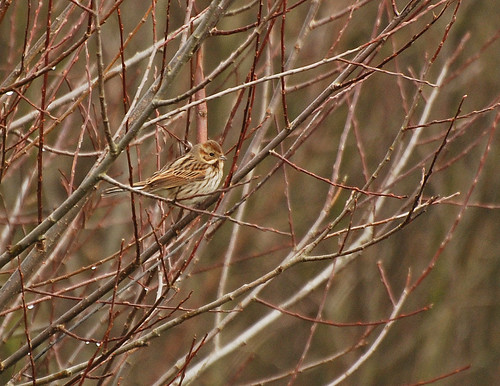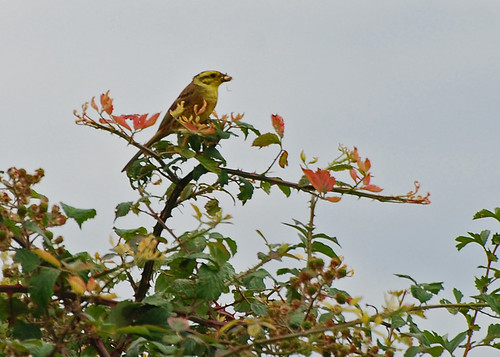The blogging Muse left me in the Spring and I switched to acquisition mode, since when I’ve been out and about taking a lot of photographs. I’ve now got enough images to keep me posting until the end of the year so I’ve reverted to posting mode and at the same time I’ll be catching up with all my fellow bloggers who I’ve been neglecting for too long!
At the end of April the sunny weather prompted me to take an early morning walk around Wicken Fen. At that time of year fairly large areas of flat pasture immediately adjacent to the fen are flooded and provide habitat for overwintering waterfowl, along with all the other winter visitors and early spring migrants to be found on the Fen. So in good weather at that time of year there’s usually plenty of wildlife. The pasture which isn’t flooded is managed by grazing it with Highland cattle:
I’m no expert on cattle so I don’t know for sure, but because this old guy was on his own and also because of the sheer size of him, I think that he’s a bull (and he didn’t stand up to allow unambiguous gender assignment by an amateur observer). He was absolutely enormous, even laying down I estimate the top of his head was around 5 feet off the ground, he was the size of a car!
Back to the birds though, one which I’ve only seen at reserves on the coast before is the bearded tit (Panurus biarmicus, Dansk: skægmejse), but on this particular morning there was at least two of them flitting around the reed beds between The Mere and Adventurers Fen.
I’m yet to get a really good photograph of a bearded tit and this one continues the tradition. It would have been OK but it is too blue because I didn’t have my glasses on when I set the white balance, so I mistook the ‘sun’ setting for the ‘incandescent light’ setting. Alas, an unavoidable consequence of hurtling into middle age! I tried to post process the image but alas I couldn’t get it to look quite right so I decided to leave it as it is and own up to my incompetence!
The bearded tit is a resident breeder and passage/winter visitor and there are only around 600 breeding pairs in the UK, so it’s good to know they are just up the road from where I live. Their conservation status is amber in the UK due to a recent decline in their breeding range but they are not a species of concern in Europe as a whole. They live and breed in reedbeds and feed on invertebrates in the summer and seed in winter.
Another iconic inhabitant of the Wicken reedbeds is the marsh harrier (Circus aeruginosus, Dansk: rørhøg). The colour of the sky reveals the weather on this glorious April morning as a male marsh harrier thermalled overhead. He was in the company of eight others, and that’s an amazing sight.
 A marsh harrier gaining height as the earth warmed up in the early morning sunshine
A marsh harrier gaining height as the earth warmed up in the early morning sunshine
The marsh harrier frequents reedbeds and marshland and feeds on frogs, insects, reptiles and small vertebrates. Its conservation status is amber in the UK due to its small non-breeding population and a localised breeding population, but as with the bearded tit its not a species of concern in Europe. It almost died out in the UK in the 1960’s but has recovered since then and has changed its behaviour by starting to also nest on farmland, and many individuals now overwinter here too. Those that migrate head down to central and southern Africa for the winter. Another recent raptor success story along with sparrowhawks and red kites, but still a work in porogress to secure the UK population.
Small songbirds such as the reed bunting (Emberiza schoeniclus, Dansk: rørspurv) were busy proclaiming their availability from the tops of the hedgerows, but the highlight of the trip was a small group of around half a dozen wheatear (Oenanthe oenanthe, Dansk: stenpikker) feeding in a field adjacent to the Fen as I arrived:
The name ‘wheatear’ may derive from the archaic ‘white arse’ which is a local name for it in some parts of England. It’s a migrant breeder in the UK and overwinters in Africa. After the last ice age its range extended northwards with the retreating ice, but they still all migrate back to Africa in the winter, even those individuals that breed in Alaska!
The female is also a striking bird even though she doesn’t have the same slate grey back and black eye stripe that the male does.
I watched the wheatears for 20 minutes or so before heading on to the Fen and when I returned around 3 hours later they had all gone. So it appears it was an overnight rest and refuelling stop for them before heading further north and west to their summer breeding grounds.







































































